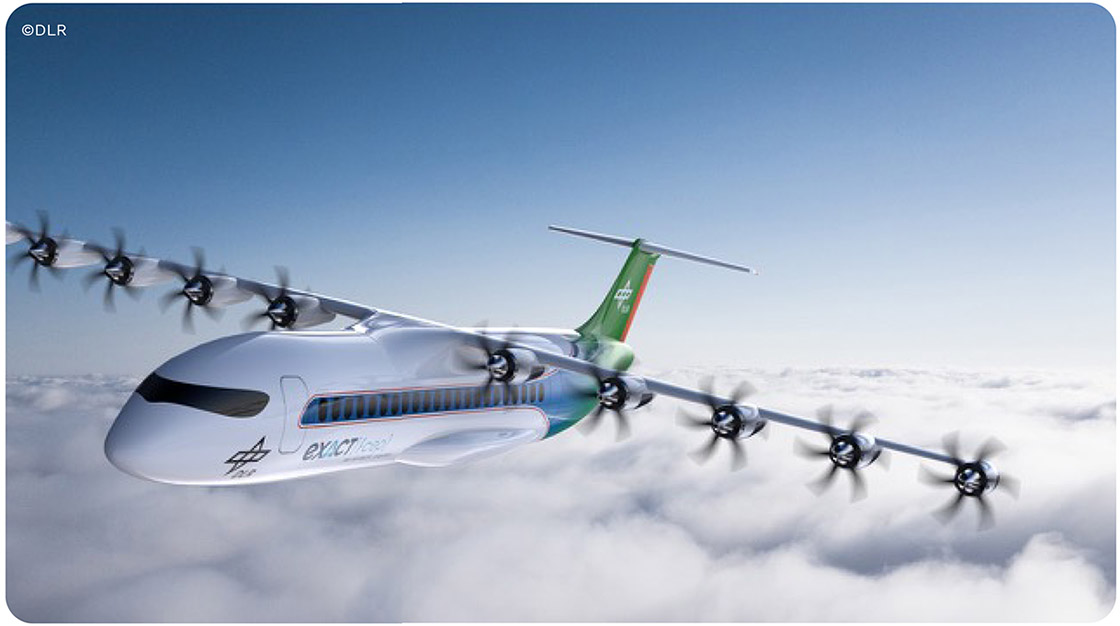Clean Aviation Joint Undertaking, the European Union's public-private partnership dedicated to supporting European aviation industry’s path towards climate neutrality, has launched its first Call for Proposals for innovative solutions powering the next generation of climate-neutral aircraft of the future.
A key part of the solution is hydrogen
Hydrogen eliminates CO2 emissions in flight completely and can be produced carbon-free. Considering non-CO2 emissions as well, the latest estimates show that hydrogen combustion could reduce the climate impact of flight by up to 75%, and fuel-cell propulsion by up to 90%.
Faced with a rapidly advancing energy crisis, the EU is investing heavily in clean hydrogen – outlining hydrogen as one of the promising renewable energy sources that will help phase out the use of fossil fuels under the new REPowerEU plan.
However, adapting aircraft designs and systems to hydrogen as a fuel or energy source will require significant research and development, fleet and infrastructure investment, and the development of accompanying regulations to ensure safe and economically viable hydrogenpowered air transport. That's where the innovative brain-power of the Clean Aviation and Clean Sky community will come into play!
Hydrogen is radically different to kerosene, with different properties and consequently, different requirements. Hydrogen fuel has a very high energy content by mass, 4 times higher than kerosene. A particular challenge is that it occupies 3 times the volume of kerosene for an identical amount of energy in liquid form and 2-4 times more in compressed gaseous form, hence storing enough of it for an aircraft to have a useful operating range requires out-of-the-box thinking. Add to that the need to store liquid hydrogen at -253°C and it's clear that there are still some major challenges to be addressed.
Several technological challenges are ahead: enhancing the overall efficiency of using hydrogen fuel with lighter tanks and fuel cell systems, distributing liquid hydrogen throughout the aircraft, building gas turbines capable of burning hydrogen with low-NOx emissions, and the development of efficient refuelling technologies enabling flow rates comparable to kerosene.
A study that was commissioned together by the Clean Aviation and the Clean Hydrogen Joint Undertakings in 2020 found that hydrogen – as a primary energy source for propulsion, either for fuel cells, direct burn in gas turbine engines or as a building block for synthetic liquid fuels – can feasibly power aircraft with an entry into service by 2035 for short-range aircraft. Costing less than €18 extra per person on a short-range flight, and reducing climate impact by up to 90%, hydrogen can play a central role in the future mix of aircraft and propulsion technologies.
The study showed that hydrogen propulsion is best suited for commuter, regional, and short- to medium-range aircraft within the considered time frame, which is one of the reasons why our current Call – as well as Clean Aviation in general – focuses on these segments of the aviation market.
There is another reason why we focus on these aircraft: flights below 4000km in length – which are largely performed by these aircraft – are currently responsible for approximately 2/3 of world-wide aviation CO2 emissions.
The study assumes that hydrogenpowered short- to medium-range, commuter and regional aircraft could account for 40% of all aircraft by 2050, with this share further increasing after 2050. The other 60% of aircraft will be powered by drop-in sustainable aviation fuels [SAF] – basically biofuels and so-called e-fuels. These too can help reduce aviation's net- CO2 emissions but will have a less dramatic impact compared to hydrogen-based propulsion.
Through our Call, we are searching for disruptive technologies and breakthrough innovations that can make the best use of hydrogen fuel possible in the aircraft of the future. Fresh, big-picture thinking will be needed and we are looking for the best solutions to the technological challenges posed by hydrogen!
With a budget of €736 million for this first Call alone, our new aircraft concepts will be able to decrease aircraft carbon emissions by no less than 30% by 2035, compared to 2020 state-of-the-art technology, which will pave the way towards climateneutral aviation by 2050.
As part of this First Call for Proposals, amongst others, we are searching for a team that can develop a ground test of a Hydrogen Integrated Propulsion System based on stateof- the-art components targeting identification of failure modes by a full "virtual flight test".
We are also scouting for a consortium that can put together a complete drive train system iron bird including propulsive and non-propulsive loads at a high Technology Readiness Level. As well as that, we would like to see a flight test of a small-scale liquid hydrogen integral tank.
The full list of the 14 different technological challenges, spread out across our three main thrusts – disruptive technologies for hydrogen, hybrid and full electric concepts, and ultra-efficient aircraft architectures – have been identified for innovators to address and can be found on the Clean Aviation website.
To find out more about Clean Aviation and the work that we do, I encourage you to visit our website. Here you will also find information about the demonstrators and the progress made in the Clean Sky 2 Programme, as well as our ambitions for a future, greener Europe. We believe that disruptive innovation will enable us to fly clean and carbon-neutral aircraft by 2035, allowing us to continue to reap the benefits that aviation can bring, without jeopardising the environment.

Contact details
Clean Aviation Joint Undertaking, White Atrium Building TO56 – 4th floor, B-1049 Brussels
Tel: +32-2-221 81 52
Email: info@clean-aviation.eu
Web: www.clean-aviation.eu